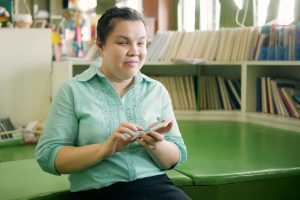Guide to Designing Inclusive User Interfaces for People with Visual Impairments | Monika Tak
Welcome
Hello everyone! My name is Monika Tak and welcome to my page in the virtual exhibit on guidelines to designing inclusive and accessible interfaces for people with visual impairments.
Intro
A few years back, there were an estimated 253 million people with visual impairments worldwide. They did not see the world as the rest of us. They also can’t do things like the rest of us. Also, in today’s world, almost every person irrespective of their abilities owns a smartphone. But how do people with visual impairments use their “touchscreen” phones?
Research around this topic says that these people are more receptive to tactile feedback.
The main aim of use of this guide is to make designers understand the importance of inclusivity while designing or developing any interface. This guide will act as a resource to help interface developers design interfaces that are inclusive of all their users.
Inclusivity in Interfaces
Interfaces appear different to everyone. They appear even more different to people with visual impairments like low vision, colourblindness etc. How they perceive interfaces says a lot about its friendliness. We navigate through them easily, but a lot of people who are differently-abled struggle to do it which in turn causes mental stress. One of the main cognitive distortions of human nature is drawing conclusions about a diverse world by relying on personal experience. Current social network systems cannot address the challenges of an inclusive society. It is important to follow an exploratory design approach. The focus should be on different views among users, designers and developers, generating different perspectives and diversity in thinking. Usability and accessibility should always be considered while designing a product or service.

Overview
Here’s an overview of my research study.
Video transcript
Hello everyone, welcome to my page on the exhibit! The title of my research is “Guide to designing inclusive user interfaces for people with visual impairments”
The big idea is to make interfaces more accessible and inclusive of visually impaired individuals. Almost every person around the world owns a smartphone today which needs to be inclusive of all its users, including those who are differently-abled.
My target audience for this study is visually impaired individuals between the ages of 18 to 35 since they are affected more by the use of these devices. And a smartphone is something that almost everyone uses.
But people with disabilities might not be able to use it in the exact same way as others.
So, we as designers need to be more empathetic while designing interfaces so that it benefits the population at large.
So while conducting research for this topic, I observed that visually impaired individuals are great at tactile reception and that could be a good starting point for this study.
I also understood that inclusivity often focuses on optimisation for accessibility without compromising the experience of users.
Although there are some notable differences between mobile devices and desktops include the lack of tactile feedback, ubiquity, limited screen size, small virtual keys, and high demand for visual attention. These differences have caused unprecedented challenges to users.
I plan to use the Design Thinking Methodology to conduct this research. It helps in finding solutions that actually work.
Basically, It is an iterative process that involves 5 steps: Empathize – Define – Ideate – Prototype – Test
“Design for All” is the main objective behind choosing this topic. While working on a product that will be accessible to all, it is important to incorporate the feedback received after each step. No user should feel excluded while using any product or service.
Thank you for watching. Hope you enjoy the rest of the exhibit!

